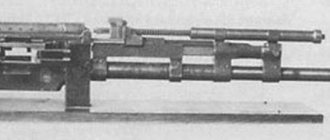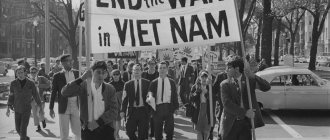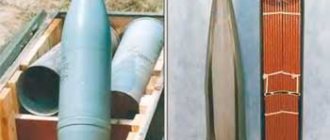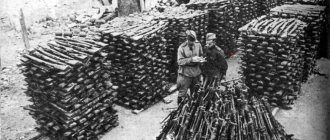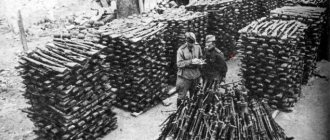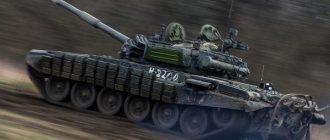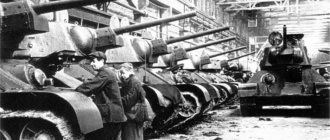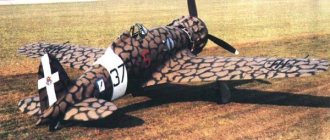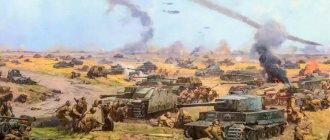Infantry flamethrowers | USSR
High explosive flamethrower FOG-1
High explosive flamethrower FOG-2
FOG-3 in combat position
The FOG-1 high-explosive flamethrower was put into service in July 1941. It was a single-use weapon and consisted of a cylinder with a guide barrel (fire hose), through which a flammable mixture was ejected under the pressure of powder gases. The incendiary device was mounted on the fire nozzle. At the position, the flamethrower was installed in a special trench, carefully secured and driven by low voltage electric current. Initially, the flamethrower had two removable attachments, allowing it to fire a flamethrower stream in a certain direction or cover a certain area with fire. Subsequently, only one directional nozzle was preserved. At the end of 1942, a new flamethrower called FOG-2 entered service. In it, an incendiary bomb and a powder charge were placed in one glass and activated by one electric fuse. The fire hose was shortened. The flamethrower had two pins with ears for tying a cord or cable, with the help of which it was possible to roll it along the ground. In total, more than 15 thousand flamethrowers were produced. Flamethrower performance characteristics: length – 700 mm; diameter – 280 mm; curb weight - 52 kg; fire mixture tank capacity – 25 l; jet range - 100 m: the affected area with a five-nozzle head with a liquid fire mixture is a circle with a radius of 90 - 100 m, with a viscous fire mixture - a circle with a radius of 45 - 50 m; the range of destruction with a single-nozzle tube with a liquid fire mixture is 59 - 60 m, with a viscous fire mixture - 130 - 140 m.
Backpack flamethrower ROKS-2
The ROKS-2 flamethrower was the result of a modernization of the ROKS-1 flamethrower and was put into service at the beginning of 1940. It consisted of a stamped tank with a fire mixture, made in the form of a backpack, a cylinder with compressed gas, a fire gun connected to the tank with a flexible hose and equipped automatically active igniter, belt suspension. The peculiarity of the flamethrower was that it looked like a regular weapon, the tank with the fire mixture was shaped like a soldier’s backpack, and the launching device itself looked like a rifle.
Backpack flamethrower ROKS-3
The flamethrower was obtained as a result of simplification in 1942 ROKS-2. It had two cylindrical tanks on the machine. The launcher also looked like a rifle, but was easier to manufacture. It featured an improved ignition device, improved firing mechanism and valve sealing, and a shorter gun. “ROKS-3” operated as follows: compressed air, located in a cylinder under a pressure of 150 atm, entered the reducer, where its pressure was reduced to an operating level of 17 atm. Under this pressure, the air passed through the tube through the check valve into the tank with the mixture. Under the pressure of compressed air, the fire mixture flowed through an intake tube located inside the tank and a flexible hose into the valve box. When the trigger was pressed, the valve opened and the fire mixture rushed out along the barrel. On the way, it passed through a damper, which extinguished the screw vortices that arose in the fire mixture. At the same time, the firing pin, under the action of the spring, broke the primer of the ignition cartridge, the flame of which was directed by the visor towards the muzzle of the fire hose gun and ignited the stream of fire mixture as it flew out of the tip. In total, about 55 thousand flamethrowers were produced during the war. Flamethrower performance characteristics: gun length – 940 mm; curb weight – 23 kg; fire mixture tank capacity – 10 l; jet range of viscous fire mixture - 40 m; number of shots - 6–8.
125 mm ampoule launcher
The 1941 ampoule flamethrower of the Kartukov system was produced in 1940-1943. and was a throwing device for incendiary projectiles. It consisted of a steel tube with a closed breech, a firing mechanism, a bolt, a sighting bar, and a machine or fork rest. The factory machine was initially wheeled, but during the war, ampoules were produced with a tubular machine in the form of a tripod or were replaced with improvised objects. An ampoule with a fire mixture was loaded from the muzzle and fired with a charge of black powder. When it hit the target, it collapsed, scattering a flammable mixture around. Despite the fact that the ampulolet was mass-produced, it was often made handicraft. The projectile used was a glass (AK-1) or tin (AZh-2) ball filled with flammable liquid “KS”. Sometimes mines or smoke bombs were used. Despite the fact that the ampoule gun was withdrawn from service in 1942, in fact it was used even in 1945. The ampoule gun was superior to backpack flamethrowers in range and accuracy, but had imperfect capsules with a fire mixture. Very fragile during transportation and shooting, they were at the same time too strong when thrown into soft ground or snow.
Ampoule gun crews, which were effective in defense, were easily vulnerable in attack.
There were problems with the production and filling of ampoules. Ampoule guns were used against enemy tanks, bunkers and bunkers, and dugouts to “smoke out” and “burn out” the enemy. Captured ampoules were used by Germany and Finland. In total, about 4 thousand flamethrowers were fired. Flamethrower performance characteristics: caliber – 125 mm; weight – 10 – 15 kg; machine weight – 5 – 18 kg; rate of fire – 5-8 shots; sighting range – 100-120 m; maximum range – 250 m; calculation 3 people. Share to:
LiveInternetLiveInternet
Quote from Helg1980
Read in full In your quotation book or community!
Flamethrower units of the Red Army
A characteristic feature of the development of the views of Soviet military science on the use of flamethrower weapons in the pre-war period was that these views never denied the importance of flamethrowers in modern warfare. Meanwhile, most foreign armies, as a result of an incorrect assessment of the experience of the First World War, came to the Second World War with an underestimation or even complete denial of the importance of flamethrower weapons. The experience of the war in Spain, the fighting at Khalkhin Gol, and especially the experience of the Soviet-Finnish war confirmed that flamethrower weapons. And in general the use of fire as a weapon. not only has it not lost its importance as a melee weapon, but on the contrary, it is acquiring a major role in modern warfare, especially when breaking through fortified defenses with powerful long-term structures. By the beginning of the Great Patriotic War, the Red Army had well-established views on the use of flamethrower weapons in battle. It was believed that the flamethrower did not solve independent combat missions. Therefore, flamethrower units were to be used only in close cooperation with infantry and tanks, artillerymen and sappers. Flame throwing had to be combined with rifle and machine gun fire and a bayonet strike. The task of flamethrowers in an offensive was to burn out the defending enemy from cover. The practice of using flamethrowers in battles has shown that after flamethrowing, unaffected personnel, as a rule, left cover and came under fire from small arms and artillery. One of the tasks of subunits and units of high-explosive flamethrowers in the offensive was to hold captured lines and bridgeheads. In defense, flamethrowers were supposed to be used suddenly and massively at the moment when the attacking enemy approached the range of a flamethrower shot. Relevant instructions and manuals were published on the combat use of flamethrowers and the training of flamethrowers. By the beginning of the Great Patriotic War, the flamethrower units and units of the Red Army were armed with: the ROKS-2 backpack flamethrower and the ATO-41 automatic tank flamethrower. In addition, in border fortified areas and in arsenals, a small number of old-style flamethrowers (Tovarnitsky, SPS, etc. systems) have been preserved. In April 1941, the FOG-1 high-explosive flamethrower was designed, intended to combat enemy infantry and tanks. ROKS-2 The ROKS-2 backpack flamethrower was a metal tank worn by the flamethrower on his back, connected by a flexible hose to a gun, which allowed the flammable mixture to be released and ignited. The practice of combat use of backpack flamethrowers has revealed a number of shortcomings, and above all the imperfection of the incendiary device. In 1942, it was modernized and named ROKS-3. It had an improved ignition device, an improved firing mechanism and valve sealing, and a shorter gun. In the interests of simplifying the production technology, the flat stamped tank was replaced by a cylindrical one. ROKS-3 In 1942, the ATO-41 automatic tank flamethrower, which was in service, was also improved. The new ATO-42 flamethrower, installed on the T-34 tank, had a fire mixture supply of 200 liters, which made it possible to fire 20 shots at a range of up to 130 meters. The ATO-42 flamethrower installed on the KV tank had a fire mixture reserve of 570 liters for 57 rounds. Flamethrower tanks KV-8 and OT-34 The high-explosive flamethrower FOG-1 was adopted for service at the beginning of the war by decree of the State Defense Committee of July 12, 1941. The high-explosive flamethrower was a single-use weapon and consisted of a cylinder with a guide barrel (fire hose), through which a flammable mixture was ejected under the pressure of powder gases. The incendiary device was mounted on the fire nozzle. At the position, the flamethrower was installed in a special trench and carefully secured. High-explosive flamethrower In 1942-1943, a gradual transition was made from the high-explosive flamethrower FOG-1 to the FOG-2 flamethrower. In the new model, the guide barrel (fire cannon) was shortened, which made it possible to move (roll) the flamethrower on the ground under enemy fire. For ease of transportation (rolling), axles with ears were welded to the barrel and bottom of the flamethrower, to which the rod (cable, twine) was attached. The electrical method of activating the flamethrower (detonation) was supplemented by a more reliable mechanical method using a mine universal fuse (MUF). FOG-2 and the method of installing high-explosive flamethrowers On the eve of the war, units of backpack flamethrowers (flamethrower teams) were organizationally part of the rifle regiments. However, due to the difficulties of using them in defense due to the short range of flamethrowing and the unmasking features of the ROKS-2 backpack flamethrower, they were soon disbanded. Instead, in November 1941, teams and companies were created, armed with ampoules and rifle mortars for throwing brass (glass) ampoules and incendiary bottles at tanks and other targets. Filled with a self-igniting KS mixture, they also had significant drawbacks and were withdrawn from service in 1942. Ampoules and ampoules In May-June 1942, at the direction of the Supreme Command Headquarters, the first eleven separate companies of backpack flamethrowers (orro) of three platoons were formed. The company had 120 backpack flamethrowers. Subsequently, the formation of companies continued. In June 1943, most of the ORROs were reorganized into separate battalions of backpack flamethrowers (obro). The battalion consisted of two flamethrower and one motor transport companies. In total, the battalion had 240 backpack flamethrowers. The battalions were intended to operate as part of assault detachments and groups of rifle units and formations when breaking through fortified enemy areas and fighting in large cities. At the beginning of 1944, part of the obro was included in the engineering and sapper brigades. At the beginning of the war, flamethrower tanks were removed from tank regiments and at their expense, in the summer of 1942, five separate flamethrower tank battalions (10 KV tanks and 11 T-34s in each) and one separate flamethrower tank brigade of the RVGK of three battalions were formed (59 tanks). In addition, in 1944, flamethrower tank regiments were created as part of the assault engineering brigades. The formation of high-explosive flamethrower units was started by decision of the Supreme Command Headquarters in August 1941. By the end of September 1941, fifty separate companies of high-explosive flamethrowers (orfo) were formed, and by January 1942, another 93 companies were intended to strengthen rifle units and formations in anti-tank terms. A separate company of high-explosive flamethrowers consisted of three platoons of 60 high-explosive flamethrowers each. In total, the company had 180 high-explosive flamethrowers, which were transported on 32 horse-drawn carts. Combat operations already in the winter of 1941 revealed the low maneuverability of companies of this composition, and in January 1942, 5 trucks with a carrying capacity of 3 tons were introduced into their staff for transporting flamethrowers, and the number of flamethrowers was reduced to 135. Further experience in the combat use of units and subunits of high-explosive flamethrowers showed the feasibility of their massive use on long firing lines. This led to the enlargement of parts of high-explosive flamethrowers. In mid-1943, from the existing separate companies of high-explosive flamethrowers, the formation of two types of battalions began: separate motorized anti-tank flamethrower battalions (omptob) and separate flamethrower battalions (oob). Omptob consisted of three flamethrower companies and an automobile company. Considering that in combat practice the battalion had to solve problems independently, without cover by infantry and its firepower, in December 1943 a machine gun company was introduced into its composition, which was armed with 9 heavy machine guns. In total, the command center had 540 high-explosive flamethrowers and 72 vehicles. The OOB consisted of three companies with 216 flamethrowers each and support units. To transport flamethrowers and property, the battalion had 27 vehicles and horse transport (45 horses). Flamethrower battalions were intended to destroy enemy tanks and manpower by flamethrowing. All flamethrower units (individual companies and battalions) were included in the reserve of the Supreme Command Headquarters and were assigned to the fronts for reinforcement. For the first time, massive units of high-explosive flamethrowers were used during the defense on the distant and near approaches to Moscow (October-November 1941). During the same period, the most rational methods of combat use of high-explosive flamethrowers and combat formations of units were developed. Combat experience led to the creation of “flamethrower bushes”, which are an ordinary full-profile rifle trench with a slight overlap and a communication passage entering the general communication entrance or trench. In front of the trench, at a distance of 1 to 4 meters, 5-8 flamethrowers were installed with the direction of flamethrowing on the most likely paths of movement of enemy tanks and infantry, as well as towards neighboring “flamethrower bushes” to create a continuous field of fire and to the rear, the flamethrowers were located in the trench. “Flamethrower bushes” were installed at a distance of 100-200 meters from one another along the front and in depth. Based on the possible maximum flamethrowing range. Each “flamethrower bush” could be put into operation independently or together with neighboring ones. Some cases of decentralized use of flamethrower companies during defensive operations in the fall of 1941 turned out to be inappropriate. The centralized combat use of flamethrower companies ensured massing and a fairly wide front of fire cover. The companies were located in firing positions in one or two echelons. With a single-echelon arrangement, their battle formation was built in a line, angled back (forward), with a ledge behind one of the flanks. Flamethrower company. By placing flamethrowers in “bushes” it could cover a front 1500-2500 meters long. The battle formations of the flamethrower battalions were identical to company formations. One battalion could create a continuous flamethrowing zone at the front up to 3.0-3.5 km with a battle formation depth of up to 400-800 meters. During the offensive leading to combat operations in large populated areas (cities), as well as when performing special tasks (burning barriers and various objects, participating in ambushes, destroying individual targets, etc.), combat experience showed the possibility of decentralized use of high-explosive flamethrowers. Already in the first baptism of fire, individual companies of high-explosive flamethrowers showed themselves well in solving the following tasks: securing joints and flanks of formations; strengthening anti-tank defense in tank-hazardous areas deep in our battle formations; ensuring the preparation of counterattacks by second echelons and reserves. The units of backpack flamethrowers received their first combat test during the Battle of Stalingrad. Experience has shown that the centralized combat use of units of backpack flamethrowers during counterattacks (i.e., in offensive operations) and even in defense is inappropriate due to the short range of destruction of the enemy. At the same time, good results were achieved when individual flamethrowers (or small groups) were included in infantry units. This use of backpack flamethrowers, as a rule, was very effective and provided great assistance to the infantry in conditions of street combat among rubble and destruction. Flamethrower companies and battalions of backpack flamethrowers were used, as a rule, in the direction of concentrating the main efforts (main strikes) of formations, by subordinating them entirely (in some cases by company or platoon) to combined arms commanders. The use of flamethrower tanks was basically similar to the use of linear tanks, however, a tank flamethrower, having in some cases a greater psychological impact on the enemy than a cannon, required significant proximity to the target. The principles and methods of combat use of flamethrower units were basically developed by the end of 1943. The main operational and tactical principles of the combat use of flamethrower units were the following: 1. Massive use in the main direction of the front and army During the period when the enemy tried to break through to Stalingrad through Kotelnikovo-Abganerovo (beginning of August 1942), 12 out of 18 companies were used to strengthen the defense of the southwestern front of the external defensive contour. 12 flamethrower units took part in the Iasi-Kishinev operation as part of the troops of the 2nd and 3rd Ukrainian fronts, 13 took part in the assault on Koenigsberg - 16, Budapest - 14, Berlin - as part of the troops of the 1st Belorussian and 1st Ukrainian fronts flamethrower units. 2. Close interaction with other branches of the military and types of flamethrower and incendiary weapons. 3. Echeloning of flamethrower-incendiary weapons along the depth of the combat formation of units and formations, as well as the operational formation of the front and army. Separate battalions of high-explosive flamethrowers, as a rule, were used centrally and were intended to provide flanks and joints of formations and formations; holding captured lines and bridgeheads; repelling enemy counterattacks and counterattacks together with second echelons or reserves; destruction (burning out) of garrisons of long-term engineering structures and fortified buildings during combat operations in large cities, as well as as part of mobile barrage detachments. Individual companies and battalions of backpack flamethrowers, which had high maneuverability, were used decentralized as part of assault groups and detachments. They were entrusted with the task of burning out enemy garrisons from long-term fire installations and fortified buildings, blocking enemy strongholds and fighting tanks, assault guns and armored personnel carriers. Particularly successful were the actions of backpack and high-explosive flamethrowers in street battles, where they demonstrated high combat effectiveness and, at times, indispensability in solving a number of problems. In addition to losses in manpower and military equipment, flamethrowers inflicted great moral damage on the enemy, as evidenced by many cases of panicked flight of the Nazis from strong points and fortifications at which flamethrowing was carried out. Numerous examples of combat operations testify to the effectiveness of flamethrower weapons and the courage of flamethrowers. Here are just a couple of episodes: During the period of defensive operations near Moscow, the 26th separate company of high-explosive flamethrowers (company commander Lieutenant M. S. Sobetsky) on December 1, 1941, equipped firing positions in the battle formations of rifle units of the 32nd Infantry Division (5th army, Western Front). The company operated as a platoon, covering individual directions of possible attacks by enemy infantry and tanks. During the battle, the company's 1st flamethrower platoon repelled an enemy attack, and the 2nd flamethrower platoon, operating in the depths of our defense, destroyed three tanks and a large group of machine gunners. In total, during the battle, the Nazis lost 4 tanks and more than 120 soldiers and officers. For the exemplary performance of the combat mission, the 26th separate company of high-explosive flamethrowers was the first of the flamethrower units to be awarded the Order of the Red Banner. The 4th separate motorized anti-tank flamethrower battalion (battalion commander Captain V.V. Kostyuchenko) courageously defended a bridgehead in the area of the village of Shchuchinka on the right bank of the river during October 2-11, 1943. Dnieper.
Backpack flamethrower ROKS-3 Structurally, a backpack flamethrower consists of a tank for a fire mixture, a cylinder for compressed air, a reducer, a flexible hose connecting the tank with a fire-hose gun, a fire-hose gun and carrying equipment. ROKS-3 operated as follows: compressed air, located in a cylinder under a pressure of 150 atm, entered the reducer, where its pressure was reduced to an operating level of 17 atm. Under this pressure, the air passed through the tube through the check valve into the tank with the mixture. Under the pressure of compressed air, the fire mixture flowed through an intake tube located inside the tank and a flexible hose into the valve box. When the trigger was pressed, the valve opened and the fire mixture rushed out along the barrel. On the way, it passed through a damper, which extinguished the screw vortices that arose in the fire mixture. At the same time, the firing pin, under the action of the spring, broke the primer of the ignition cartridge, the flame of which was directed by the visor towards the muzzle of the fire hose gun and ignited the stream of fire mixture as it flew out of the tip. TTX ROKS-3 Weight of equipped flamethrower, kg 23 Weight of one flamethrower charge, kg 8.5 viscous fire mixture Number of ignition cartridges 10 Number of short shots 6-8 Number of long shots 1-2 Flamethrowing range, m 40 (at tailwind - up to 42 m) High-explosive flamethrower FOG-2 The FOG-2 flamethrower has the following device and principle of operation: the flamethrower tank has 2 holes. A glass for a powder charge is welded into one of them, and a siphon pipe is placed into the other. The upper part of the pipe ends in a nozzle, on which a membrane is attached with a union nut, closing its opening. When equipping a flamethrower, a powder charge was placed in the charging cup, and an incendiary bomb was placed on top of it. An electric igniter or a mechanical igniter with a tension or pressure impact device was placed in the bomb. When the fuse was triggered, the incendiary bomb ignited, which ignited the powder charge. The flame resulting from the burning of the checker was thrown out in the form of a torch through the pilot hole in the glass. The gases formed during the combustion of the powder charge squeezed the fire mixture through the siphon pipe to the membrane. The membrane was cut off due to high pressure, and the fire mixture was thrown out of the nozzle. Flying out of it, it was ignited by the fire of an incendiary bomb and flew towards the target in the form of a burning jet. TTX FOG-2 Weight of equipped flamethrower, kg 32 Weight of one flamethrower charge, kg 20 Number of shots 1 Flamethrowing range, m 100-110 Ampoule thrower. The ampulomet consisted of a barrel with a chamber, a bolt, a firing device, sighting devices and a carriage with a fork. The barrel is a pipe rolled from 2 mm iron sheet. Sights included a front sight and a folding sight post. The barrel was attached with pins to the fork of a carriage - a tripod, a wooden block or a frame on skis. The projectile was a tin ampoule AZh-2 or a glass ball with 1 liter of the “KC” mixture, fired with a 12-gauge blank hunting cartridge. Loading was carried out by two people - the first crew number inserted the expelling cartridge from the treasury, the second put the ampoule itself into the barrel from the muzzle. Ampulometres were very simple and cheap “flame-throwing mortars”; they were armed with special ampoule-thrower platoons - the 1942 infantry combat manual mentions the ampulomet as a standard infantry fire weapon. In battle, the ampoule gun often served as the core of a group of tank destroyers. Its use in defense generally justified itself, but attempts to use it offensively led to large losses of crews due to the short firing range. True, they were used not without success by assault groups in urban battles - in particular, in Stalingrad. At the end of 1942, ampoules were removed from service. Performance characteristics of the ampulo gun Ampulo gun weight - 10 kg Carriage weight - from 5 to 18 kg Sighting range - 100-120 m Maximum - 240-250 m with the main charge and up to 400 m with an additional charge Crew - 3 people Rate of fire - 6-8 rounds/min Ammunition load - 10 ampoules and 12 knockout cartridges. Tank flamethrowers. OT-34-85 and OT-130 By the beginning of 1941, the automatic tank flamethrower ATO-41 was designed and put into service. The ATO-41 could be mounted on any linear tank, and the artillery armament was retained. Thanks to this, the flamethrower not only did not reduce the firepower of the tank, but, on the contrary, increased it. The ATO-41 flamethrower mounted on the T-34 tank had a fire mixture supply of 100 liters and could fire 10 one-second shots at a distance of up to 100 meters. According to the principle of operation, the ATO-41 was a multiple-action piston flamethrower and at the beginning of the war it was one of the most advanced examples of tank flamethrowers. ATO-42 In 1942, designers created the ATO-42 tank flamethrower. In it, they increased the supply of flamethrower mixture by using spare tanks of motor fuel on the medium T-34 tank to 200 liters, on the heavy KV tank - to 570 liters. As a result, the flamethrower on the T-34 could fire 20 ten-liter shots, and on the KV tank - 57 shots. In addition, the ATO-42 had a greater flamethrowing range than previous systems (up to 120 m). The rate of fire of the ATO-42 is one shot every two seconds. Flame throwing could be carried out with single shots and automatic bursts. Diagram of the ATO-42 flamethrower equipment of the OT-34 tank The operating principle is the same as high-explosive flamethrowers, i.e. the force of powder gases is used to throw the fire mixture (in ATO-41/42 blank cartridges from a 45 mm gun were used). When the charge was detonated, the powder gases pressed on the piston, pushing the fire mixture out of the cylinder, which was ignited by a gasoline torch ignited by an electric ignition system. Up to 10 liters of fire mixture were thrown out in one shot. It was possible to shoot either single or in bursts of 4-5 shots, thanks to the presence of a mechanism for automatically recharging the fire mixture using compressed air. Rifle mortars. At the beginning of the war, a special rifle mortar appeared for throwing incendiary bottles using a wooden wad and a blank cartridge, with the butt resting on the ground. Bottles for this purpose were selected with thicker and more durable glass. The target firing range of a bottle from such a “bottle launcher” was 80 m, the maximum was 180 m, the rate of fire for 2 people was 6-8 rounds/min. During the battles near Moscow, they tried to assign two such mortars to a rifle squad, and 6-8 to a platoon. However, the accuracy of “mortar shooting” turned out to be low, bottles often broke at the moment of firing, so this method was not widely used. The mortars themselves were later adapted for throwing delayed-action thermite bombs of the TG5Sh type or smoke bombs when shelling bunkers or bunkers. However, during the battles in Stalingrad, “bottle launchers” designed by worker I.P. Inochkin were not manufactured. 24 mm rifle mortar: I - barrel; 2 - block; 3 - neck; 4 - combat channel of the block; 5 - transverse channel; 6 - threaded hole; 7 threaded plug; 8 — sleeve Molotov cocktails (“Molotov cocktail”) At the beginning of the war, the State Defense Committee decided to use flammable bottles in the fight against tanks. Already on July 7, 1941, the State Defense Committee adopted a special resolution “On anti-tank incendiary grenades (bottles)”, which obliged the People’s Commissariat of the Food Industry to organize, from July 10, 1941, equipping liter glass bottles with a fire mixture according to the recipe of the Research Institute 6 of the People’s Commissariat of Ammunition. And the head of the Military Chemical Defense Directorate of the Red Army (later the Main Military Chemical Directorate) was ordered to begin “supplying military units with hand incendiary grenades” from July 14. Dozens of distilleries and beer factories throughout the USSR quickly turned into military enterprises. Moreover, the “Molotov Cocktail” (named after the then deputy of I.V. Stalin for the State Committee for Defense) was prepared directly on the old factory lines, where just yesterday they bottled citre, port wines and fizzy “Abrau-Durso”. From the first batches of such bottles, they often did not even have time to remove the “peaceful” alcohol labels. In addition to the liter bottles specified in the legendary Molotov decree, the “cocktail” was also made in beer and wine-cognac containers with a volume of 0.5 and 0.7 liters. Two types of incendiary bottles were adopted by the Red Army: with self-igniting liquid KS (a mixture of phosphorus and sulfur) and with flammable mixtures No. 1 and No. 3, which are a mixture of aviation gasoline, kerosene, naphtha, thickened with oils or a special hardening powder OP- 2, developed in 1939 under the leadership of A.P. Ionov, - in fact, it was the prototype of modern napalm. The abbreviation “KS” stands for differently: “Koshkin mixture” - after the name of the inventor N.V. Koshkin, and “Old Cognac”, and “Kachugin-Maltovnik” - after the name of other inventors of liquid grenades. A bottle with self-igniting liquid KS, falling on a solid body, broke, the liquid spilled and burned with a bright flame for up to 3 minutes, developing a temperature of up to 1000°C. At the same time, being sticky, it stuck to the armor or covered inspection slits, glass, and observation devices, blinded the crew with smoke, smoking them out of the tank and burning everything inside the tank. A drop of burning liquid falling on the body caused severe, difficult to heal burns. Combustible mixtures No. 1 and No. 3 burned for up to 60 seconds with temperatures up to 800 ° C and emitting a lot of black smoke. Bottles with gasoline were used as a cheaper option, and thin glass tube ampoules with CS liquid, which were attached to the bottle with apothecary rubber bands, served as an incendiary agent. Sometimes ampoules were placed inside bottles before throwing. Soviet “bottle weapon” - during the Great Patriotic War: a - an incendiary bottle with a simple fuse - a match fixed in the neck of the bottle, which the fighter set on fire with a special grater; b - a chemical fuse that is inserted inside the bottle and ignites when the ampoule is broken; c - external ampoules-fuses that ignite when broken; d - external fuse with its own igniter and detonator capsule; d - a bottle with self-igniting liquid KS and an insulating layer of water and kerosene on top. The effectiveness of the bottles was determined not only by the properties of the mixture, but also by the method of its ignition. Initially, in the simplest version, as already noted, the bottle was plugged with a cork, and before throwing the fighter had to replace it with a rag plug soaked in gasoline, which was then set on fire. The operation took a lot of time, making the bottle ineffective and even dangerous for the fighter himself. In another version, the fuse could be two matches (sticks covered along the entire length with an incendiary composition), secured to the neck with an elastic band. The infantryman set them on fire with a special grater or an ordinary box. In August 1941, a more reliable chemical fuse was adopted by A. T. Kuchina, M. A. Shcheglov and P. S. Maltovnik: an ampoule with sulfuric acid, bertholite salt and powdered sugar was attached to the bottle with an elastic band. The fuse ignited as soon as the ampoule broke along with the bottle. To increase the reliability of ignition when hitting the target (and this was the main problem), 3-4 ampoules were attached to the bottle in a circle. In 1941, Tula gunsmith G. Korobov developed a simple mechanical ignition mechanism with a blank rifle cartridge similar to a simplified grenade fuse. It, like the ampoule, was tied to the side of an ordinary half-liter filled with gasoline. When a bottle is broken, a rope is released that holds a simple pin with a spring and a striker. The firing pin breaks the primer of a blank pistol cartridge and the powder flash ignites the spilled incendiary mixture. The most effective were bottles filled with self-igniting liquids KS and BGS, which are a yellow-green solution containing phosphorus and sulfur. The liquids ignited simply from contact with air after breaking the bottle. It was these liquids that received the widely known nickname “Molotov cocktail.” In order to protect the liquid from contact with air before using the bottle, when equipping the bottle, a layer of water and kerosene was poured on top, and the cork was additionally secured with electrical tape or wire. The recipe included an additive that was flammable even at -40°C. Instructions for use were attached to each bottle. In the absence of fuses, it was recommended to use the bottles in the following sequence: first throw a bottle with KS liquid, and then one or two bottles with mixture No. 1 or No. 3. The front-line soldiers demanded: “More bottles with KS - they make tanks burn like matches.” On August 12, 1941, the People's Commissar of Defense approved the “Instructions for the use of incendiary bottles.” According to it, regiments and divisions began forming and training groups of tank destroyers with grenades and incendiary bottles, and it was the latter that then made up the largest share of anti-tank weapons. And soon all personnel began to be trained to use bottles. In the anti-tank instructions, next to the arrows indicating the vulnerable spots of enemy tanks, in addition to the inscriptions “hit with a shell” or “hit with a grenade,” the unusual “hit with a bottle” appeared. Incendiary bottles had to be thrown onto the roof of the engine compartment, and this was only possible when the tank approached almost closely or after it passed over the trench. The throwing range was set to 30 m, but in reality it was 15-20 m. Throwing bottles was successful from trenches and crevices. Experienced fighters spent an average of 2-3 bottles to destroy a tank. The bottles went well with the pomegranates. Tank destroyers practiced this technique: throwing an anti-tank grenade or a bunch of grenades into the chassis of the tank, and after it stopped, throwing a bottle at the stern. Incendiary bottles were also intended to destroy bunkers and bunkers, manpower in shelters and aircraft in parking lots. Bottles quickly became a common weapon for partisans. They were also widely used in the system of anti-tank and anti-personnel barriers. In defensive battles near Moscow, “fire shafts” and “fields” were already used. The fire shafts were made from various flammable materials and set on fire with KS bottles. In minefields, incendiary bottles were placed in a checkerboard pattern in combination with anti-tank mines. In the middle of the war, the practice of creating “fire mines” spread - about 20 bottles were placed around an anti-tank mine in a radius, which upon explosion produced a column of fire up to 8 m high, striking an area of about 300 m with burning liquid. The combat count of the bottles is impressive. According to official data, during the war years, with their help, a total of 2,500 tanks, self-propelled guns and armored vehicles, 1,200 bunkers and bunkers, 2,500 other fortified structures, 800 vehicles and 65 military warehouses were destroyed.
(c) ursa-tm.ru
High Explosive Flamethrower
High Explosive
(
powder
)
flamethrower
- a type of jet flamethrower, the principle of operation of which is based on throwing an incendiary mixture not due to the pressure of compressed air supplied from a cylinder (the so-called pneumatic flamethrower [1][2]), but due to the pressure of the powder gases formed during detonation special propellant charge; in turn, high-explosive flamethrowers are divided into piston and pistonless. Both backpack and heavy and tank flamethrowers[3][4][5][6] can have a high-explosive principle of operation.
Compared to a jet flamethrower with a traditional operating principle, a high-explosive flamethrower is characterized by a higher pressure in the tank and, as a result, a higher initial speed of the ejected fire mixture and a significantly larger effective range; this was the reason that the principle of using powder gases became predominant in the design of jet flamethrowers [3][4][5][6].
The world's first high-explosive flamethrower was the Russian heavy SPS, proposed in June 1916 by engineers Stranden, Povarnin and Stolitsa and had a mass of 32.5 kg, a range of 35-50 m and an action time of 1-2 seconds[4][5][7 ]. At the beginning of 1917, the flamethrower entered mass production at the Kazan Oil Refinery, built a year earlier, where 362 copies of the device were produced before the end of the First World War. The first combat use of the SPS occurred during the defense of the Red Army Kakhovsky bridgehead in the fall of 1920[5].
Some Soviet tank flamethrowers of the interwar period also had a high-explosive principle of operation, for example, an automatic powder flamethrower designed by NATI[8].
During the Second World War in the USSR, heavy single-shot high-explosive flamethrowers FOG-1 and FOG-2[6], which became the most famous and recognizable among similar devices[7]. The principle of pressure of powder gases of a propellant charge was also used in the design of almost all tank flamethrowers created during this period and installed on Soviet flamethrower tanks: ATO-41, ATO-42, OTOG[10]. In 1942, Nazi Germany adopted the Abwehrflammenwerfer 42 high-explosive flamethrower, which was a copy of the FOG-1.
In the post-war period, the high-explosive principle of operation practically replaced the supply of compressed gas from cylinders in the designs of jet flamethrowers, and remains predominant to this day [5]. In the 1950s, the backpack LPO-50 and heavy TPO-50 were created in the USSR, which were in service with the armies of the USSR and some other states (LPO-50 was withdrawn from service in the 1970s, while the more effective TPO-50 continues be in service with the armies of Russia and China)[3][4][6][11][12]. Also, the principle of using powder gas pressure was used by all Soviet post-war tank flamethrowers: ATO-1, OM-250, ATO-200.
German single-shot high-explosive flamethrower Abwehrflammenwerfer 42 period of the Second World War, a copy of the Soviet FOG-1
Heavy infantry flamethrower TPO-50 in the KDVO Museum (Khabarovsk)
Paratroopers with a spark, or Why flamethrowers are used in battle
The RCBZ units are not only radiochemical and biological protection. Specialists of this type of troops are the only ones in the Russian army who can use combat flamethrowers.
A 21st century flamethrower is not at all the same as a mid-20th century flamethrower. Of course, we, ordinary people, imagine jets of flame escaping from the barrel in the hands of a fighter, burning everything in its path. Meanwhile, modern RPO (rocket-propelled flamethrowers) “deliver” flames to a distance of up to 600 meters; in fact, a modern flamethrower (for example, “Bumblebee”) is something like an RPG, from the barrel of which a rocket is launched. Upon hitting the target, the projectile disintegrates into splashes of hellish (up to 900 degrees!) flame.
What are flamethrowers used for in battle? To suppress the enemy, to drive groups out of pillboxes and fortified positions. They are also used for assault - so it would be quite logical to assume that there are flamethrower units in the 31st separate air assault brigade. It’s not just that they exist – the flamethrowers of the Ulyanovsk brigade are the best in Russia. But first things first.
Guard Sergeant Konstantin Vyshidenko has been “playing with fire” for six years now; he is now the commander of the flamethrower section of the RKhBZ platoon of the 31st brigade.
— When I came to the contract, I didn’t know anything about the RCBZ, I knew about protective equipment, gas masks. I didn’t know that chemical protection also includes flamethrowers,” the man shares. — What can you say about the soldiers who serve in the RCBZ? These are specialists, people of scientific knowledge.
In a splash of flame
Of course, half a century ago, flamethrowers were used as weapons of demoralization - the damage to manpower was small, which was more than compensated for by the fear that the weapon sowed in the ranks of the enemy. Nowadays, a flamethrower is, first of all, a means of effectively destroying enemy personnel. The 31st Brigade has three flamethrower squads. The fighters are not only trained, but also physically strong: a pack with two disposable “pipes” (after a shot becomes useless) of 920 cm each weighs about 22 kilograms. In a combat situation, a flamethrower may need not one pack, but two, and this is already 44 kilograms of cargo.
— In the RKhBZ, all units have their own task: reconnaissance chemists are closer to headquarters and monitor the situation, and we, flamethrowers, go with armored personnel carriers, we are always at the forefront. The unit is always followed by a KamAZ truck loaded with flamethrowers. If necessary, weapons can be transported from it.
In addition to the “disposable” flamethrowers, the commanders are armed with light infantry flamethrowers - they are already reusable, with one projectile in the barrel, three in the magazine. And of course, every soldier has a machine gun.
— First of all, we are paratroopers. We undergo parachute, shooting, and physical training. But if the combat situation requires the use of flamethrowers, we are the ones who are trained for this,” adds the sergeant.
Best in the Airborne Forces and second in Russia
In March of this year, flamethrowers of the 31st brigade turned out to be the best among airborne units in Russia. Nine teams took part in the competition.
“We turned out to be more prepared,” says Konstantin. — We have gone through all the stages. We used combat flamethrowers - no mock-ups, everything was real. It took place near Tula, at the training ground. Flamethrowers had to be used to hit a mock-up pillbox. Get into the window to destroy the entire position.
The position literally fell apart - a special work team reassembled the pillbox every time. Representatives of each military unit fired two shots. True, because of the wind, some people set fire not to the pillbox, but to a piece of land several tens of meters away from it. Ulyanovsk flamethrowers hit the pillbox both times.
“The repair team reassembled the pillbox for us twice,” the man laughs.
Oh, by the way: last year Ulyanovsk flamethrowers became second in Russia among all branches of the military.
Andrey TVOROGOV
Lords of Fire: how flamethrowers were used during the war
On December 9, 1941, the chairman of the State Defense Committee, Joseph Stalin, signed decree No. 1005 on the formation of flamethrower companies. By December 25, it was necessary to form 15 separate flamethrower companies in the Moscow Military District and 15 in the Volga District, each numbering 127 people. At the same time, a reserve flamethrower battalion of up to 1,500 people was created in the Volga District, and a staff of 150 instructors was also recruited.
The forerunners of flamethrower companies were flamethrower teams, which even before the war were formed in the chemical protection platoons of rifle regiments. In August 1941, the first flamethrower company appeared on the Northern Front. However, it existed for only 2 months and was disbanded. The fact is that the first experiments in using flamethrowers at the front did not produce the expected results. The range of the ROKS-2 backpack flamethrower was only 20-30 meters. The flamethrower could not act effectively, since at such a short distance from the enemy he could be killed even before he tried to use the flamethrower device. In addition, ROKS-2 (the backpack flamethrower of Klyuev and Sergeev) was not reliable.
Therefore, the flamethrower companies formed in December 1941 were armed differently. Their arsenal included ampoules and rifle mortars. Both devices were supposed to throw ampoules with the flammable substance COP, as well as bottles with a spontaneously combustible mixture.
In 1942, assault groups began to be formed, and flamethrowers were assigned to them. The flamethrower companies themselves were re-equipped: backpack flamethrowers were returned, this time the more reliable ROKS-3. In addition, flamethrower systems that were supplied under Lend-Lease, as well as high-explosive flamethrowers from the FOG, also arrived. In the summer of 1942, they returned to the practice of forming separate flamethrower companies. During defensive battles, when rifle units were in trenches, flamethrowers had to protect both flanks, so they were located on the right and left edges of the defense. During the offensive, the duty of the flamethrowers was to suppress enemy firing points. For example, for the first time, flamethrowers noticeably showed themselves on the Stalingrad front, where the 171st and 172nd companies of backpack flamethrowers operated. The command of the 62nd Army noted their role in the liquidation of German bunkers with a special order.
In June 1943, the formation of separate battalions of backpack flamethrowers also began, while some of the previously formed companies remained in service.
When the Red Army entered Germany and Hungary, the role of flamethrowers increased. Especially when storming cities and fortified areas. They performed well in the Budapest and Keningsbury operations, “smoking” the enemy out of hiding. During the battles, 13 companies of flamethrowers received well-deserved orders on their banners.
The war for flamethrower companies and battalions ended in August 1945 in the Far East, where they had to storm the fortified areas of the Imperial Japanese Army.
Photo: Alexander Kapustyansky \ RIA Novosti
★ POPULAR PRODUCTS★
"Go"
